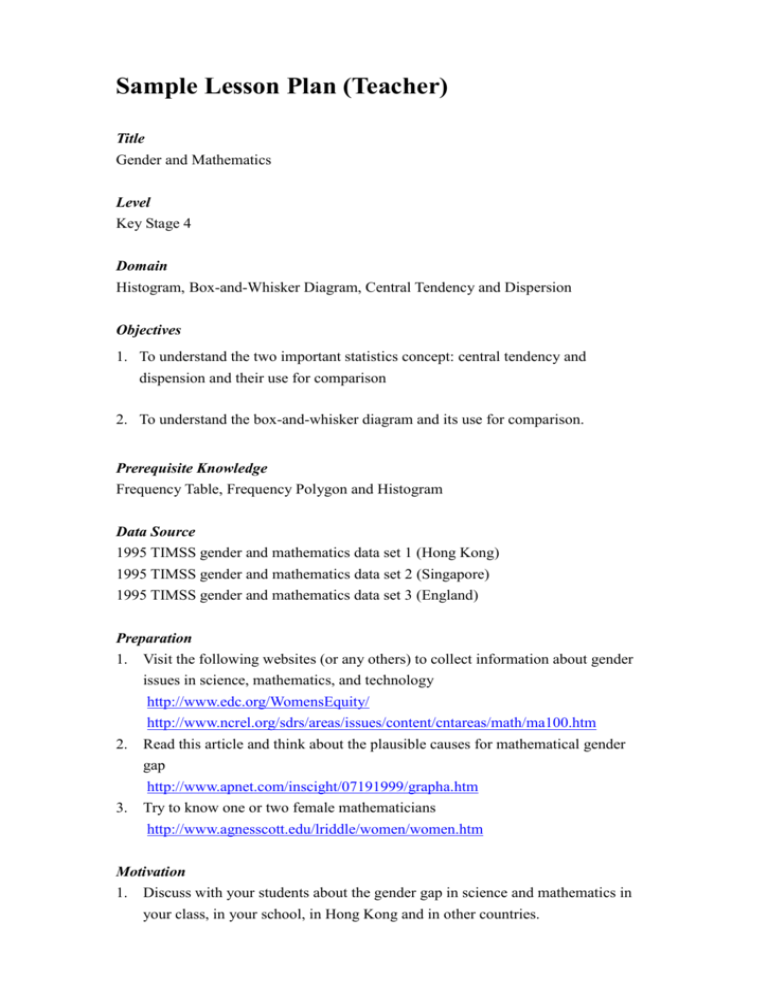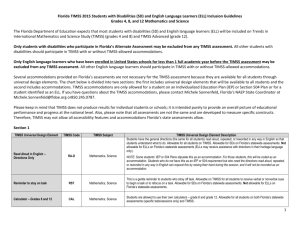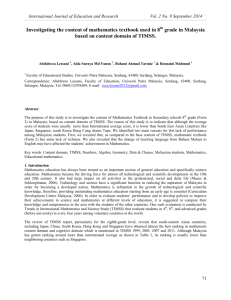Sample Lesson Plan I
advertisement

Sample Lesson Plan (Teacher) Title Gender and Mathematics Level Key Stage 4 Domain Histogram, Box-and-Whisker Diagram, Central Tendency and Dispersion Objectives 1. To understand the two important statistics concept: central tendency and dispension and their use for comparison 2. To understand the box-and-whisker diagram and its use for comparison. Prerequisite Knowledge Frequency Table, Frequency Polygon and Histogram Data Source 1995 TIMSS gender and mathematics data set 1 (Hong Kong) 1995 TIMSS gender and mathematics data set 2 (Singapore) 1995 TIMSS gender and mathematics data set 3 (England) Preparation 1. Visit the following websites (or any others) to collect information about gender issues in science, mathematics, and technology http://www.edc.org/WomensEquity/ http://www.ncrel.org/sdrs/areas/issues/content/cntareas/math/ma100.htm 2. Read this article and think about the plausible causes for mathematical gender gap http://www.apnet.com/inscight/07191999/grapha.htm 3. Try to know one or two female mathematicians http://www.agnesscott.edu/lriddle/women/women.htm Motivation 1. Discuss with your students about the gender gap in science and mathematics in your class, in your school, in Hong Kong and in other countries. 2. Discuss with your students about the plausible causes of mathematical gender gap. Main Task 1 1. Ask your students to fill in the following survey questions in your class. Part I – Personal Information 1. Gender 2. Class: 3. Level: Male Female (F.1 – F.7) ________ ________ Part II – Confidence in mathematics learning (SA = Strongly Agree) (A = Agree) (D = Disagree) (SD = Strongly Disagree) 4. I usually do well in mathematics SA A D SD 4 3 2 1 5. Mathematics is an easy subject SA A D SD 4 3 2 1 Part III – Attitudes towards mathematics learning SA A D SD 1 2 3 4 7. I would like a job that involving using mathematics 6. Mathematics is boring SA A D SD 4 3 2 1 Part IV – Last test/examination score Your score is _______ 2. Teach your students to use various summary statistics and graphing tools of Stat.Net to summarize the results of Part II (Q2+Q3), Part III(Q4+Q5) and Part IV. 3. By splitting boys and girls in the data file and using various summary statistics and graphing tools, ask your students to analyze and discuss the gender differences in Parts II to III, and IV. Main Task 2 1. Discuss with your students about the difficulties in investigating the Hong Kong situation. [Briefly introduce the concept of sampling and the standardizaed test for mathematical achievement] 2. Open the 1995 TIMSS dataset 1 with over 5,000 S1-2 respondents. [Briefly introduce the TIMSS research and the Hong Kong results]. 3. Ask your students to find the approximate number of boys and girls by using Stat.Calc. 4. Ask your students to get the histogram, box-and-whisker diagram, the mean and standard deviation of the whole sample. 5. By splitting boys and girls in this data file and using the histograms, box-and-whisker diagram, means and standard deviations etc., ask your students to analyze and discuss the gender differences in Parts II to IV. Exercise 1. Investigate the gender differences in Singapore, by using dataset2. 2. Investigate the gender differences in England, by using dataset3. Enrichment Investigate the between-country differences. Compare these between-country difference with the between-gender differences. Which are more significant (not in rigorous statistical comparison sense)? Why (just proposing plausible causes)? Remarks You can use these large datasets to demonstrate normal distribution. You may also mention about the importance of sampling procedure and normal distribution for rigorous statistical comparison. Proposed Follow up Project Construct an online school survey to collect data for all students in your school and report on the mathematical gender gap within your school. Analysis may include the comparison of the results for different classes, levels. Students may be encouraged to propose plausible causes for such differences. Furthermore, you can ask your students to compare the school situation with the Hong Kong situation.








